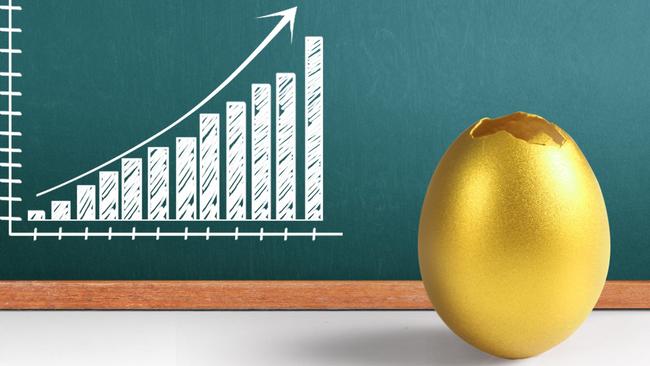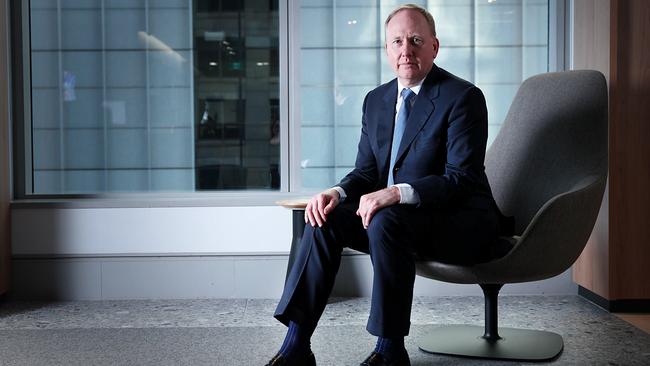Super investors told of subdued outlook for their funds after recent stunning returns
Top super funds have delivered their third best returns of the past decade but don’t expect a repeat performance this year, the sector’s investors say.

Business
Don't miss out on the headlines from Business. Followed categories will be added to My News.
The nation’s top super funds have delivered their third best returns of the past decade and the highest since 2021 – but don’t expect a repeat performance this year, the sector’s investors warn.
Colonial First State chief investment officer Jonathan Armitage expects average returns to falling back to single digits in 2025, with volatile inflation and US tariff threats among the key risks to watch in the months ahead.
“We’ve had a couple of years of very strong investment returns, particularly from equity markets. But if you look at average returns over the last 15 years or so, they’re about half of what we’ve seen in recent years. So I’d suggest returns will move back to much more normalised levels (in 2025),” Mr Armitage told The Weekend Australian.
“And it’s fair to say that we may well have brought forward future returns for our members.”
Mid-to-high single digits is most likely for fund returns next year, in line with the long-term average of 7-9 per cent, according to Mr Armitage.
A move back to returns below 10 per cent would be a painful decline from the stellar 20 per cent-plus the nation’s big super funds are set to deliver for members in 2024.
Analysis by SuperRatings shows that the median balanced option returned 11.5 per cent for 2024, and most options delivered a return of more than 10 per cent, while the top providers achieved 12.5 per cent.

SuperRatings chief executive Kirby Rappell said 2025 would be about inflation and the return of volatility, which despite global economic uncertainty had yet to translate into momentum in super returns slipping.
“Globally, we see increased discussion around trade and tariffs, which may see a flow through impact to returns if implemented. Domestically, while we have seen inflation slowing, uncertainty remains on whether it will continue to slow in line with expectations and when interest rate relief will occur,” Mr Rappell said.
Since 2000, funds have managed a calendar year return of 6.8 per cent a year. Mr Rappell said a single-digit positive return would be a good outcome for 2025, but the core focus for most members needed to remain on ensuring they had their long-term risk settings in place.
“Funds have done a good job navigating a range of economic conditions to date, but pressures and uncertainties are never far away,” he said.
AMP group executive, super and investment Melinda Howes said she expected the new Trump administration to support sharemarkets and that the increasing use of AI would improve the productivity and profitability of large corporations.
“We are therefore currently maintaining an overweight position in US equities,” Ms Howes said. “Members approaching retirement automatically have lower exposure to growth assets at AMP, providing added protection from market downturns, while our younger members, who have time on their side to invest through market volatility, have higher exposure to growth assets.”

Mr Armitage said that if the new Trump administration pushed through tax cuts at both the corporate and possibly the personal level, that would be good for the economy.
“But there are a couple of other things we think are potential headwinds for the economy and therefore stockmarkets, including tariffs. There’s plenty of research that suggests tariffs will impact growth, and they’ll also push up inflation,” Mr Armitage said.
“The other thing, which has been getting less attention in recent weeks, is what happens around migration policies. Reducing immigration will disrupt labour markets over the next couple of years in the US; it will change the supply and demand imbalances. If that is coupled with the removal of undocumented workers, that will exacerbate those labour market pressures.”
This could also push up inflationary pressures, which would weigh on markets, he said.
Returns have been driven by a strong year for US equities, with the tech-heavy Nasdaq up 28 per cent for the year to date, the S&P 500 climbing 25 per cent and the Dow Jones Industrial Average adding 14 per cent. Over the period, the ASX 200 accumulation index gained about 13 per cent.

A large allocation to equities helped CFS’s performance during the year, as did its lack of exposure to legacy unlisted assets, Mr Armitage said.
“Some of our peers have had a little bit more of a challenging time because they’ve had exposures to real estate, but also other unlisted assets, where the returns have not been what they had expected,” he said. “Our members have benefited from us avoiding those legacy assets.”
Association of Superannuation Funds of Australia CEO Mary Delahunty said people could expect another solid year in super returns despite challenges, adding that it was accurate to describe the incoming economic conditions as drought mixed with scattered showers and whirlwinds.
“Some sectors might feel the pinch of restrictive trade and policy uncertainty, whereas deregulated industries might experience brief, localised relief and the geopolitical uncertainty mixed with inflation pressures can create whirlwinds,” she said.
Ms Delahunty said the size and sophistication of Australian super funds, now the fourth-largest pension system in the world, meant they were designed for steady growth over decades.

“Members can take confidence in the robust, diversified strategies employed by funds to navigate these challenging conditions,” she said.
Within Australia, Colonial First State saw stubborn inflation as a key risk for the market after a stronger than expected uplift in monthly inflation data published on Wednesday, which showed an uplift from 2.1 per cent to 2.3 per cent in the year to November 30.
Mr Armitage said the Reserve Bank was dealing with a different set of pressures than in Europe and the US from an inflation perspective, and how that played out in early 2025 would be critical for markets and the economy.
At the moment those inflationary pressures remain pretty stubborn, he said.
Mr Armitage said he did not see the RBA cutting rates in the near term: “If you look at the data, inflation’s still not moving down into levels where the Reserve Bank will be comfortable starting to cut rates. It may well be that we must wait a little bit longer.”
Commonwealth Bank and ANZ forecast that the Reserve Bank will begin the first of several rate cuts from February, while Westpac and NAB expect the first rate cut in May.
Mr Armitage said he saw the local sharemarket potentially coming under pressure after a strong 2024. But he was more optimistic on parts of the fixed income market, particularly corporate credit.
“Credit spreads are quite narrow at the moment, but investors are still getting strong yields at the moment,” he said.
Originally published as Super investors told of subdued outlook for their funds after recent stunning returns


